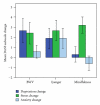A comparative randomised controlled trial of the effects of brain wave vibration training, iyengar yoga, and mindfulness on mood, well-being, and salivary cortisol
- PMID: 22216054
- PMCID: PMC3246835
- DOI: 10.1155/2012/234713
A comparative randomised controlled trial of the effects of brain wave vibration training, iyengar yoga, and mindfulness on mood, well-being, and salivary cortisol
Abstract
This randomised trial compared the effects of Brain Wave Vibration (BWV) training, which involves rhythmic yoga-like meditative exercises, with Iyengar yoga and Mindfulness. Iyengar provided a contrast for the physical components and mindfulness for the "mental" components of BWV. 35 healthy adults completed 10 75-minute classes of BWV, Iyengar, or Mindfulness over five weeks. Participants were assessed at pre- and postintervention for mood, sleep, mindfulness, absorption, health, memory, and salivary cortisol. Better overall mood and vitality followed both BWV and Iyengar training, while the BWV group alone had improved depression and sleep latency. Mindfulness produced a comparatively greater increase in absorption. All interventions improved stress and mindfulness, while no changes occurred in health, memory, or salivary cortisol. In conclusion, increased well-being followed training in all three practices, increased absorption was specific to Mindfulness, while BWV was unique in its benefits to depression and sleep latency, warranting further research.
Figures





References
-
- Moruzzi G, Magoun HW. Brain stem reticular formation and activation of the EEG. Electroencephalography and Clinical Neurophysiology. 1949;1(1–4):455–473. - PubMed
-
- Duffy E. Activation and Behavior. New York, NY, USA: John Wiley & Sons; 1962.
-
- Lee I. Brain Wave Vibration: Getting Back into the Rhythm of a Happy, Healthy Life. Best Life Media; 2008.
-
- Jung YH, Kang DH, Jang JH, et al. The effects of mind-body training on stress reduction, positive affect, and plasma catecholamines. Neuroscience Letters. 2010;479(2):138–142. - PubMed
LinkOut - more resources
Full Text Sources

